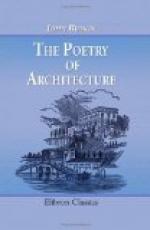[Footnote 35: [Though not in this order. C is the intellectual window; B, the imaginative one.]]
[Footnote 36: It is too much the custom to consider a design as composed of a certain number of hard lines, instead of a certain number of shadows of various depth and dimension. Though these shadows change their position in the course of the day, they are relatively always the same. They have most variety under a strong light without sun, most expression with the sun. A little observation of the infinite variety of shade which the sun is capable of casting, as it touches projections of different curve and character, will enable the designer to be certain of his effects. We shall have occasion to allude to this subject again. [See Seven Lamps of Architecture, III. 13, 23.]]
[Illustration: Fig. 13. Windows.]
181. These hints will be sufficient to explain our meaning, and we have not space to do more, as the object of these papers is rather to observe than to advise. Besides, in questions of expression so intricate, it is almost impossible to advance fixed principles; every mind will have perceptions of its own, which will guide its speculations, every hand, and eye, and peculiar feeling, varying even from year to year. We have only started the subject of correspondence with individual character, because we think that imaginative minds might take up the idea with some success, as furnishing them with a guide in the variation of their designs, more certain than mere experiment on unmeaning forms, or than ringing indiscriminate changes on component parts of established beauty. To the reverie, rather than the investigation, to the dream, rather than the deliberation, of the architect, we recommend it, as a branch of art in which instinct will do more than precept, and inspiration than technicality. The correspondence of our villa architecture with our natural scenery may be determined with far greater accuracy, and will require careful investigation.
We had hoped to have concluded the Villa in this paper; but the importance of domestic architecture at the present day, when people want houses more than fortresses, safes more than keeps, and sculleries more than dungeons, is sufficient apology for delay.
OXFORD, August, 1838.




